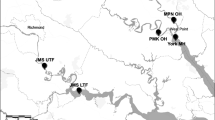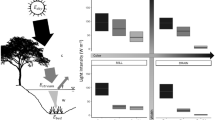Abstract
Submersed aquatic vegetation (SAV) is an important component of shallow water estuarine systems that has declined drastically in recent decades. SAV has particularly high light requirements, and losses of SAV have, in many cases, been attributed to increased light attenuation in the water column, frequently due to coastal eutrophication. The desire to restore these valuable habitats to their historical levels has created the need for a simple but accurate management tool for translating light requirements into water quality targets capable of supporting SAV communities. A procedure for calculating water quality targets for concentrations of chlorophyll and total suspended solids (TSS) is derived, based on representing the diffuse attenuation coefficient for photosynthetically active radiation, Kd(PAR), as a linear function of contributions due to water plus colored dissolved organic matter (CDOM), chlorophyll, and TSS. It is assumed that Kd(PAR) conforms to the Lambert-Beer law. Target concentrations are determined as the intersection of a line representing intended reduction of TSS and chlorophyll by management actions, with another line describing the dependence of TSS on chlorophyll at a constant value of Kd(PAR). The validity of applying the Lambert-Beer law to Kd(PAR) in estuarine waters was tested by comparing the performance of a linear model of Kd(PAR) with data simulated using a more realistic model of light attenuation. The linear regression model tended to underestimate Kd(PAR) at high light attenuation, resulting in erroneous predictions of target concentrations at shallow restoration depths. The errors result more from the wide spectral bandwidth of PAR, than from irrecoverable nonlinearities in the diffuse attenuation coefficient per se. In spite of the failure of the Lambert-Beer law applied to Kd(PAR), the variation of TSS with chlorophyll at constant Kd(PAR) determined by the more mechanistic attenuation model was, nevertheless, highly linear. Use of the management tool based on intersecting lines is still possible, but coefficients in the line describing the dependence of TSS on chlorophyll at constant Kd(PAR) must be determined empirically by application of an optical model suitably calibrated for the region of interest. An example application of the procedure to data from the Rhode River, Maryland, indicates that approximately 15% reduction in both TSS and chlorophyll concentrations, or 50% reduction in chlorophyll alone, will be needed to restore conditions for growth of SAV to levels that existed in the late 1960s.
Similar content being viewed by others
Literature Cited
Batiuk, R. A., R. J. Orth, K. A. Moore, W. C. Dennison, J. C. Stevenson, L. Staver, V. Carter, N. Rybicki, R. E. Hickman, S. Kollar, S. Bieber, P. Heasly, andP. Bergstrom. 1992. Chesapeake Bay Submerged Aquatic Vegetation Habitat Requirements and Restoration Goals: A Technical Synthesis. U.S. Environmental Protection Agency, Chesapeake Bay Program, Annapolis, Maryland.
Carter, V., N. B. Rybicki, J. M. Landwehr, andM. Naylor. 2000. Light requirements for SAV survival and growth, p. 4–15.In R. A. Batiuk, P. Bergstrom, W. M. Kemp, E. Koch, L. Marray, J. C. Stevenson, R. Bartleson, V. Carter, N. B. Rybicki, J. M. Landwehr, C. Gallegos, L. Karrh, M. Naylor, D. Wilcox, K. A. Moore, S. Ailstock, and M. Teichberg (eds.), Chesapeake Bay Submerged Aquatic Vegetation Water Quality and Habitat-based Requirements and Restoration Targets: A Second Technical Synthesis. U.S. Environmental Protection Agency, Chesapeake Bay Program, Annapolis, Maryland.
Davies-Colley, R. J., W. N. Vant, andD. G. Smith. 1993. Colour and Clarity of Natural Waters. Ellis Horwood, Chichester.
Dennison, W. C., R. J. Orth, K. A. Moore, J. C. Stevenson, V. Carter, S. Kollar, P. W. Bergstrom, andR. A. Batiuk. 1993. Assessing water quality with submersed aquatic vegetation.BioScience 43:86–94.
Duarte, C. M. 1991. Seagrass depth limits.Aquatic Botany 40: 363–377.
Gallegos, C. L. 1994. Refining habitat requirements of submersed aquatic vegetation: Role of optical models.Estuaries 17:198–219.
Gallegos, C. L., D. L. Correll, andJ. W. Pierce. 1990. Modeling spectral diffuse attenuation, absorption, and scattering coefficients in a turbid estuary.Limnology and Oceanography 35: 1486–1502.
Gallegos, C. L., T. E. Jordan, andD. L. Correll. 1992. Event-scale response of phytoplankton to watershed inputs in a subestuary: Timing, magnitude, and location of phytoplankton blooms.Limnology and Oceanography 37:813–828.
Gallegos, C. L. andW. J. Kenworthy. 1996. Seagrass depth limits in the Indian River Lagoon (Florida, U.S.A.): Application of an optical water quality model.Estuarine, Coastal and Shelf Science 42:267–288.
Gallegos, C. andK. A. Moore. 2000. Factors contributing to water-column light attenuation, p. 16–27.In R. A. Batiuk, P. Bergstrom, W. M. Kemp, E. Koch, L. Murray, J. C. Stevenson. R. Bartleson, V. Carter, N. B. Rybicki, J. M. Landwehr, C. Gallegos, L. Karrh, M. Naylor, D. Wilcox, K. A. Moore, S. Ailstock, and M. Teichberg (eds.), Chesapeake Bay Submerged Aquatic Vegetation Water Quality and Habitat-based Requirements and Restoration Targets: A Second Technical Synthesis. U.S. Environmental Protection Agency, Chesapeake Bay Program, Annapolis, Maryland.
Geider, R. J. 1987. Light and temperature dependence of the carbon to chlorophylla ratio in microalgae and cyanobacteria: Implications for physiology and growth of phytoplankton.New Phytologist 106:1–34.
Gordon, H. R. 1989. Can the Lambert-Beer law be applied to the diffuse attenuation coefficient of ocean water?Limnology and Oceanography 34:1389–1409.
Kemp, W. M., R. Bartleson, andL. Murray 2000. Epiphyte contributions to light attenuation at the leaf surface, p. 28–37.In R. A. Batiuk, P. Bergstrom, W. M. Kemp, E. Koch, L. Murray, J. C. Stevenson, R. Bartleson, V. Carter, N. B. Rybicki, J. M. Landwehr, C. Gallegos, L. Karrh, M. Naylor, D. Wilcox, K. A. Moore, S. Ailstock, and M. Teichberg (eds.), Chesapeake Bay Submerged Aquatic Vegetation Water Quality and Habitat-based Requirements and Restoration Targets: A Second Technical Synthesis. U.S. Environmental Protection Agency, Chesapeake Bay Program, Annapolis, Maryland.
Kirk, J. T. O. 1980. Relationship between nephelometric turbidity and scattering coefficients in certain Australian waters.Australian Journal of Marine and Freshwater Research 31:1–12.
Kirk, J. T. O. 1981. Monte Carlo study of the nature of the underwater light field in, and the relationships between optical properties of, turbid, yellow waters.Australian Journal of Marine and Freshwater Research 32:517–532.
Kirk, J. T. O. 1984. Dependence of relationship between apparent and inherent optical properties of water on solar altitude.Limnology and Oceanography 29:350–356.
Kirk, J. T. O. 1989. The upwelling light stream in natural waters.Limnology and Oceanography 34:1410–1425.
Kirk, J. T. O. 1994. Light and Photosynthesis in Aquatic Ecosystems. Cambridge University Press, Cambridge.
Koch, E. W. 2001. Beyond light: Physical, geological and geochemical parameters as possible submerged aquatic vegetation habitat requirements.Estuaries 24:1–17.
Lorenzen, C. J. 1972. Extinction of light in the ocean by phytoplankton.Journal du Conseil, Conseil International pour l'Exploration de la Mer 34:262–267.
Mobley, C. D. 1994. Light and Water. Radiative Transfer in Natural Waters. Academic Press, New York.
Mobley, C. D., B. Gentili, H. R. Gordon, Z. Jin, G. W. Kattawar, A. Morel, P. Reinersman, K. Stamnes, andR. H. Stavn. 1993. Comparison of numerical models for computing underwater light fields.Applied Optics 32:1–21.
Moore, K. A., W. M. Kemp, V. Carter, andC. Gallegos. 2000. Future needs for continued management application, p. 77–78.In R. A. Batiuk, P. Bergstrom, W. M. Kemp, E. Koch, L. Murray, J. C. Stevenson, R. Bartleson, V. Carter, N. B. Rybicki, J. M. Landwehr, C. Gallegos, L. Karrh, M. Naylor, D. Wilcox, K. A. Moore, S. Ailstock, and M. Teichberg (eds.), Chesapeake Bay Submerged Aquatic Vegetation Water Quality and Habitat-based Requirements and Restoration Targets: A Second Technical Synthesis. U.S. Environmental Protection Agency, Chesapeake Bay Program, Annapolis, Maryland.
Moore, K. A., R. L. Wetzel, andR. J. Orth. 1997. Seasonal pulses of turbidity and their relations to eelgrass (Zostera marina L.) survival in an estuary.Journal of Experimental Marine Biology and Ecology 215:115–134.
Morel, A. andB. Gentili. 1991. Diffuse reflectance of oceanic waters: Its dependence on sun angle as influenced by the molecular scattering contribution.Applied Optics 30:4427–4438.
Morel, A. andR. C. Smith. 1982. Terminology and units in optical oceanography.Marine Geodesy 5:335–349.
Orth, R. J. andK. A. Moore. 1983. Chesapeake Bay: An unprecedented decline in submerged aquatic vegetation.Science 222:51–53.
Smith, Jr.,W. O. 1982. The relative importance of chlorophyll, dissolved and particulate material, and seawater to the vertical extinction of light.Estuarine, Coastal and Shelf Science 15:459–465.
Southwick, C. H. andF. W. Pine. 1975. Abundance of submerged vascular vegetation in the Rhode River from 1966 to 1973.Chesapeake Science 16:147–151.
Stefan, H. G., J. J. Cardoni, F. R. Schiebe, andC. M. Cooper. 1983. Model of light penetration in a turbid lake.Water Resources Research 19:109–120.
Sverdrup, H. U., M. W. Johnson, andR. H. Fleming. 1942. The Oceans, Their Physics, Chemistry, and General Biology. Prentice-Hall, Englewood Cliffs.
Twilley, R. R., W. M. Kemp, K. W. Staver, J. C. Stevenson, andW. R. Boynton. 1985. Nutrient enrichment of estuarine submersed vascular plant communities. 1. Algal growth and effects on production of plants and associated communities.Marine Ecology Progress Series 23:179–191.
Vant, W. N. 1990. Causes of light attenuation in nine New Zealand estuaries.Estuarine, Coastal and Shelf Science 31:125–137.
Verduin, J. 1982. Components contributing to light extinction in natural waters: Method of isolation.Archiv für Hydrobiologie 93:303–312.
Weidemann, A. D. andT. T. Bannister. 1986. Absorption and scattering coefficients in Irondequoit Bay.Limnology and Oceanography 31:567–583.
Author information
Authors and Affiliations
Rights and permissions
About this article
Cite this article
Gallegos, C.L. Calculating optical water quality targets to restore and protect submersed aquatic vegetation: Overcoming problems in partitioning the diffuse attenuation coefficient for photosynthetically active radiation. Estuaries 24, 381–397 (2001). https://doi.org/10.2307/1353240
Received:
Accepted:
Issue Date:
DOI: https://doi.org/10.2307/1353240




